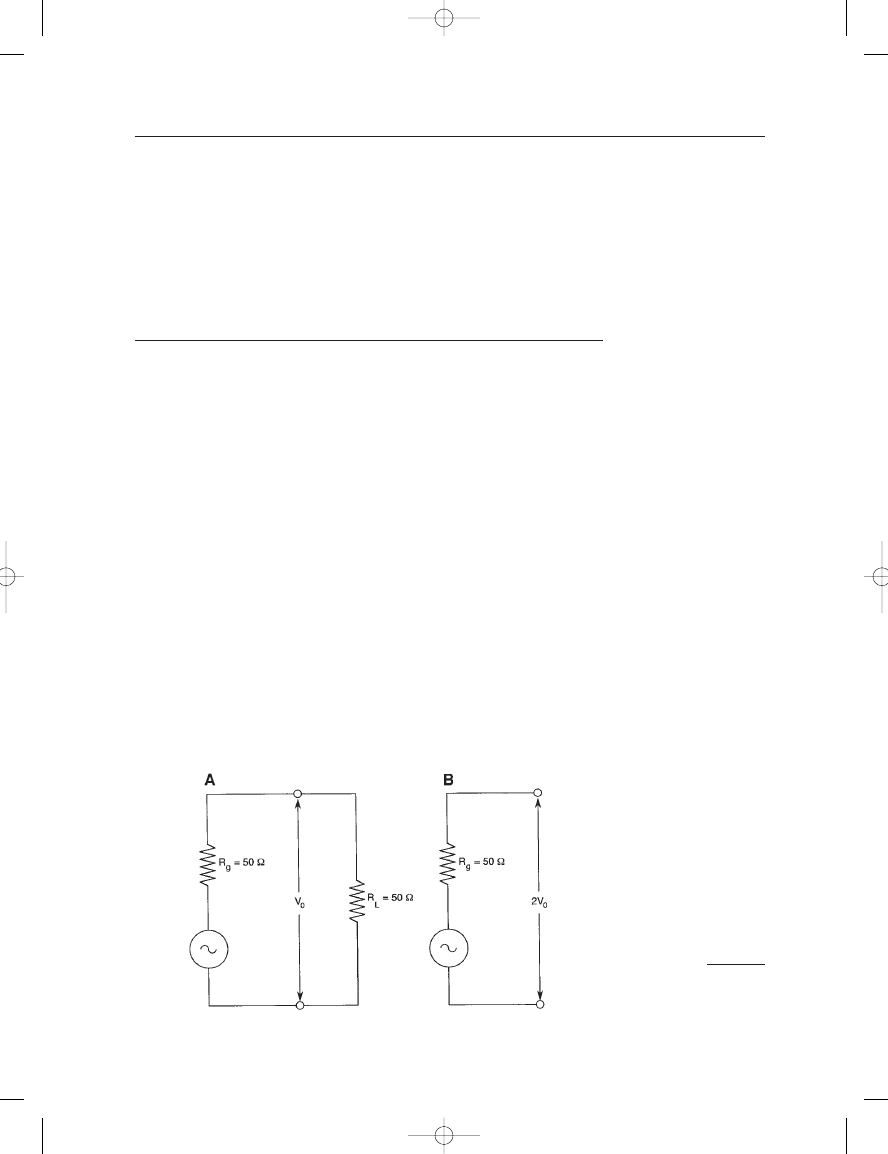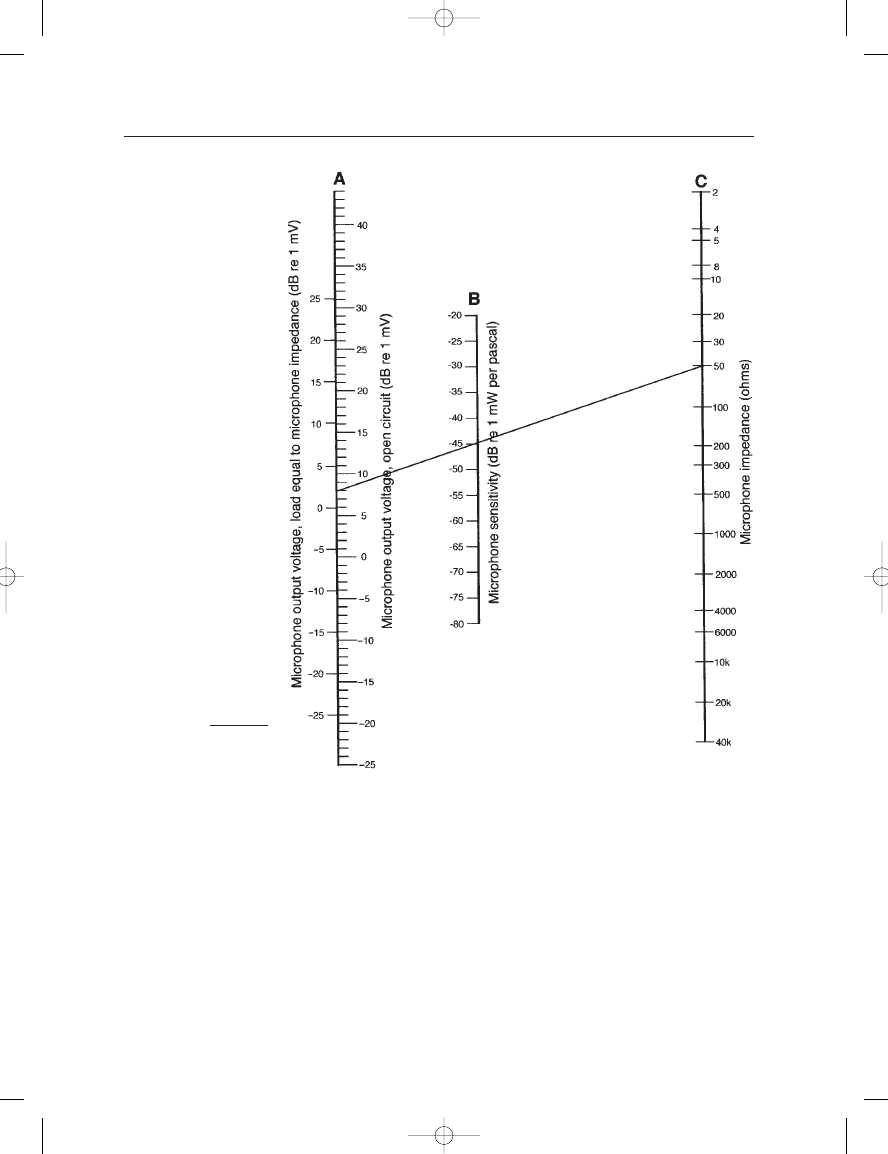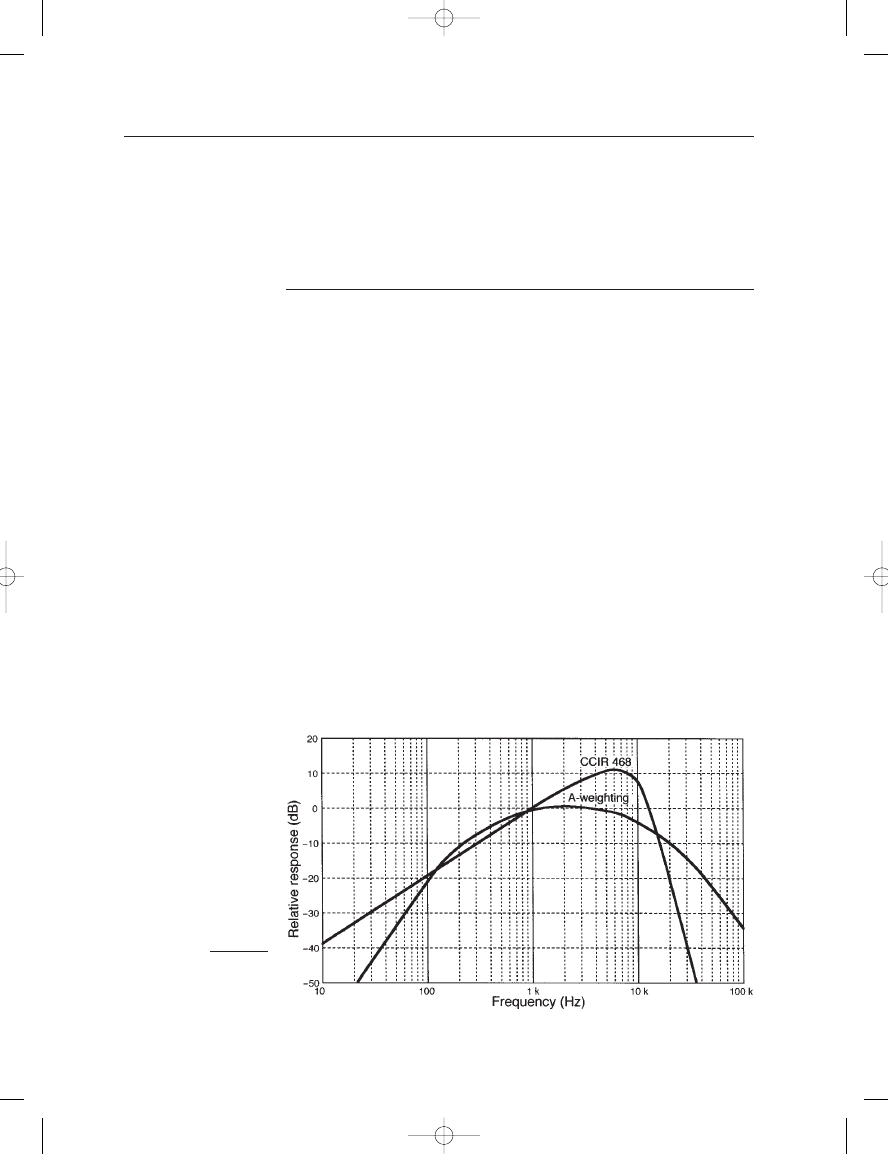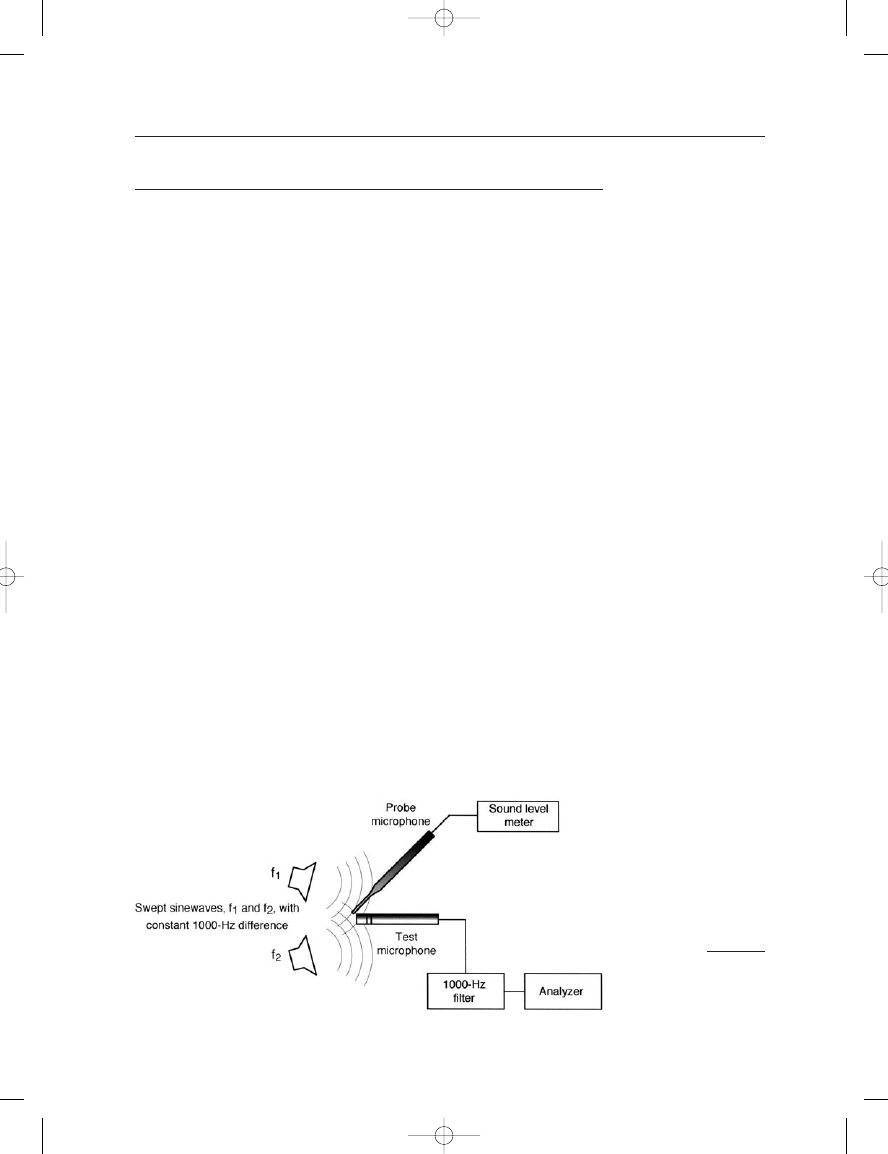ВУЗ: Казахская Национальная Академия Искусств им. Т. Жургенова
Категория: Книга
Дисциплина: Не указана
Добавлен: 03.02.2019
Просмотров: 17276
Скачиваний: 51

symmetrical about the axis throughout the frequency band. However, for
side-addressed microphones, there will be variations, especially at higher
frequencies where the asymmetry in diaphragm boundary conditions
becomes significant. Normally, this data is not shown, but there are
interests within the microphone user community to standardize the pres-
entation of more complete directional information. As present, such
additional data is presented at the discretion of each manufacturer.
MICROPHONE PRESSURE SENSITIVITY
The principal method of presenting microphone sensitivity is to state the
output rms voltage (mV/Pa) when the microphone is placed in a 1 kHz
free progressive sound field at a pressure of 1 Pa rms (94 dB L
P
). A nom-
inal microphone load impedance of 1000 ohms may be stated as well,
but the standard is normally referred to as the “open circuit” output
voltage of the microphone. Another way of stating this data is to give the
rms voltage output level in dB relative to one volt:
Output level (dBV)
20 log (rating in mVrms) 60 dB
(7.1)
MICROPHONE OUTPUT POWER SENSITIVITY
Microphone power output specifications were developed during the
early days of broadcast transmission when the matched impedance con-
cept was common. Here, the microphone is loaded with an impedance
equal to its own internal impedance, as shown in Figure 7–5A. When
unloaded, as shown at B, the output voltage is doubled.
The rating method is somewhat complicated, and we now give
an example: consider a dynamic microphone with rated impedance of
50 ohms and an open-circuit output sensitivity of 2.5 mV/Pa. In modern
specification sheets this voltage level may also be expressed as
52 dB
dBV (re 1 volt). The same microphone, if its loaded output power is
THE MICROPHONE BOOK
108
FIGURE 7–5
Microphone output
unloaded (A); loaded (B).
Earg_07.qxd 14/9/04 2:43 PM Page 108

given, would carry an output power rating of
45 dBm. This is solved as
follows.
When the microphone is given a matching load of 50 ohms, its output
voltage will be reduced by one-half, or 1.25 mV. The power in the load
will then be:
Power
(1.25)
2
/50
3.125 10
8
W, or 3.125
10
5
mW
Solving for power level in dBm:
Level
10 log (3.125 10
5
)
45 dBm
The nomograph in Figure 7–6 lets us solve this directly, as indicated by
the line that has been drawn over the nomograph. Here, we simply take
7: Microphone Measurements, Standards and Specifications
109
FIGURE 7–6
Microphone power output
nomograph.
Earg_07.qxd 14/9/04 2:43 PM Page 109

the unloaded output voltage level (re 1 mV) of
8 dB (60 52) and
locate that value at A. The nominal impedance of the microphone
(50 ohms) is located at B. A line is then drawn between the two points
and the microphone’s sensitivity, in dBm per pascal, is read directly at B.
Other rarely used variations of this method are:
1. Output in dBm per dyne per square centimeter (dBm measured in a
matched load impedance at 74 dB L
P
).
2. Output in dBm, EIA rating (dBm measured in a matched load
impedance at an acoustical level of 0 dB L
P
).
The reader can readily appreciate the simplicity and universality of
the modern open circuit output voltage rating method.
MICROPHONE SOURCE IMPEDANCE
Virtually all of today’s professional microphones, capacitor or dynamic,
are what may be called “low impedance,” as opposed to the high imped-
ance models of decades past. The range of impedance may be typically
from 50 to 200 ohms for capacitor microphones, or up to the range of
600 ohms for some dynamic models.
Since the traditional input load impedance seen by a microphone
today is in the range of 2000 to 5000 ohms, it is clear that the load
impedance is high enough that it has little measurable effect on the
microphone’s output voltage.
This being the case, the microphone’s output impedance rating is of
little practical consequence in modern systems layout. However, some
microphone preamplifiers have a control for adjusting the input circuitry
for specifically matching a wide range of microphone output imped-
ances. (See Chapter 8 under the Stand-Alone Microphone Preamp.)
NORMAL RANGES OF MICROPHONE
DESIGN SENSITIVITY
In designing capacitor microphones the engineer is free to set the refer-
ence output sensitivity to match the intended use of the microphone.
Table 7–1 gives normal sensitivity ranges.
The design criterion is simple; microphones intended for strong
sound sources will need less output sensitivity to drive a downstream
THE MICROPHONE BOOK
110
TABLE 7–1
Normal sensitivity ranges by use
Microphone usage
Normal sensitivity range
Close-in, hand-held
2–8 mV/Pa
Normal studio use
7–20 mV/Pa
Distant pickup
10–50 mV/Pa
Earg_07.qxd 14/9/04 2:43 PM Page 110

preamplifier to normal output levels, while distant pickup via boundary
layer microphones or rifle microphones will need greater output sensi-
tivity for the same purposes.
MICROPHONE EQUIVALENT SELF-NOISE
LEVEL RATING
Today, the self-noise level of a capacitor microphone is expressed as an
equivalent acoustical noise level stated in dB(A). For example, a given
microphone may have a self noise rating of 13 dB(A). What this means is
that the microphone has a noise floor equivalent to the signal that would
be picked up by an ideal (noiseless) microphone if that microphone were
placed in an acoustical sound field of 13 dB(A). Modern studio grade
capacitor microphones generally have self-noise ratings in the range from
7 dB(A) to 14 or 15 dB(A). Tube models will have higher noise ratings,
many in the range from 17 dB(A) to 23 dB(A).
As a practical matter, the self-noise of a modern capacitor microphone
will be about 10 to 12 dB greater than the equivalent input noise (EIN)
of a good console or preamplifier input stage; thus, the self-noise of the
microphone will be dominant. With a dynamic microphone this is not
normally the case; the output voltage of the dynamic microphone may be
10 to 12 dB lower than that of a capacitor model so that the EIN of the
console will dominate. As a result of this, dynamic microphones do not
carry a self-noise rating; rather, their performance must be assessed relative
to the EIN of the following console preamplifier.
Some microphone specifications carry two self-noise ratings. One of
these is the traditional A-weighted curve and the other is a psychometric
curve that is more appropriate for microphones used in non-recording
measurement purposes. The two curves are shown in Figure 7–7.
7: Microphone Measurements, Standards and Specifications
111
FIGURE 7–7
Two self-noise weighting
curves for microphone
measurements.
Earg_07.qxd 14/9/04 2:43 PM Page 111

DISTORTION SPECIFICATIONS
For studio quality microphones the reference distortion limit is established
as the acoustical signal level at 1 kHz which will produce no more than
0.5% THD (total harmonic distortion) at the microphone’s output.
Reference distortion amounts of 1% or 3% may be used in qualifying
dynamic microphones for general vocal and hand-held applications.
Microphone distortion measurements are very difficult to make inas-
much as acoustical levels in the range of 130 to 140 are required. These
levels are hard to generate without significant loudspeaker distortion. A
pistonphone (mechanical actuator) arrangement can be used with pressure
microphones where a good acoustical seal can be made, but it is useless
with any kind of gradient microphone.
It has been suggested (Peus 1997) that microphone distortion meas-
urements can be made using a twin-tone method in which two swept fre-
quencies, separated by a fixed frequency interval, such as 1000 Hz, be
applied to the microphone under test. Since the individual sweep tones
are separately generated, they can be maintained at fairly low distortion;
any difference tone generated by the diaphragm-preamplifier assembly
represents distortion and can be easily measured with a fixed 1000 Hz
filter, as shown in Figure 7–8. One problem with this method is that it is
difficult to establish a direct equivalence with standard THD techniques.
In many studio quality microphones, the distortion present at very
high levels results not from the nonlinearities of diaphragm motion but
rather from electrical overload of the amplifier stage immediately fol-
lowing the diaphragm. Accordingly, some manufacturers simulate micro-
phone distortion by injecting an equivalent electrical signal, equal to
what the diaphragm motion would produce in a high sound field, and
then measure the resulting electrical distortion at the microphone’s out-
put. This method assumes that the diaphragm assembly is not itself pro-
ducing distortion, but rather that any measured distortion is purely the
result of electrical overload. We must rely on the manufacturers them-
selves to ensure that this indeed the case.
THE MICROPHONE BOOK
112
FIGURE 7–8
Twin-tone method of
measuring microphone
distortion.
Earg_07.qxd 14/9/04 2:43 PM Page 112